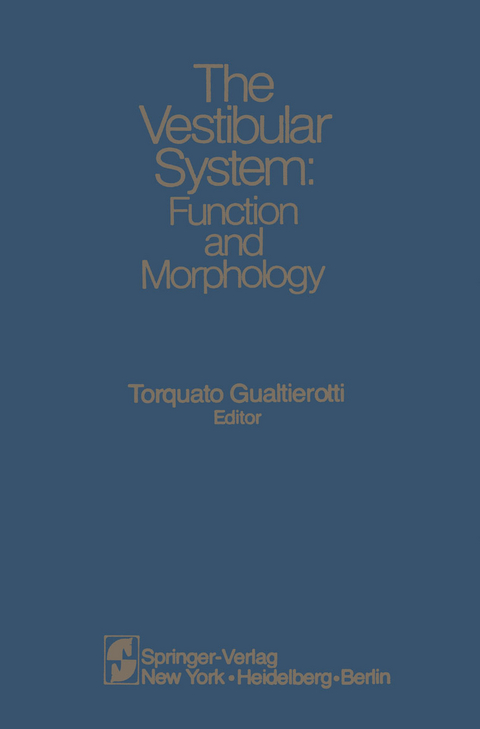
The Vestibular System
Springer-Verlag New York Inc.
978-1-4612-5904-6 (ISBN)
Vestibular physiology has acquired new interest in the past few years. The development of fast aircraft, beginning during the Second World War and continuing through modern supersonic jets and space travel, has increased dramatically the acceleration range to which man is subjected, from prolonged weightlessness to several gs. The labyrinth measures all kinds of acceleration, including gravity. and therefore has taken on particular impor tance in the study of human health in the Space Age. It is understandable. then, that NASA sponsored the Symposium on Vestibular Function and Morphology. a satellite of the Eighth Annual Meeting of the Society of Neuroscience. held October 30-November 1. 1978, at the University of Pittsburgh, which also supported the symposium. The present volume was developed from papers originally presented there. My strategy in editing this book has been to focus upon the vestibular end organ and its direct connections. both peripheral and central, in order to as sure a coherent discussion of the basics of vestibular function, structure, and ultrastructure. Fortunately, it was possible to secure the contributions of a number of outstanding investigators from both the United States and abroad, including functionally oriented morphologists. ultrastructuralists, biophysicists, and vestibular physiologists. The result is a comprehensive discussion of the main mechanisms of the labyrinth: the transduction pro cess at the receptor level, in the semicircular canals, and in the utricular and saccular maculae; the information transfer through neuronal pathways to the nuclei and the cerebellum; and the general organization of the system.
1 Morphology.- 1. The Structure of the Vestibular Sensory Epithelia.- 2. The Afferent and Efferent Vestibular Pathways: Morphologic Aspects.- 3. Otolith Organ Receptor Morphology in Herring-like Fishes.- 4. Is the Growth of the Otolith Controlled by Its Weight?.- 5. Morphologic Observations of Human Otoconial Membranes.- 6. Vestibular Nuclei: Neuronal Loss in Mice with Otoconial Agenesis and Evidence of Right-Left Asymmetry.- 7. Central Projections to the Vestibular Nuclei From the Subparafascicular Region of the Rabbit.- 8. Vestibular Projections to the Monkey Thalamus and Rostral Mesencephalon: An Autoradiographic Study.- 9. Ionic Mechanisms in the Vestibular Apparatus: The Resting State.- 10. Centrally Originating Efferent Terminals on Hair Cells: Fact or Fancy?.- 2 Morphology and Function Interrelationship.- 11. Thick and Thin Mammalian Vestibular Axons: Afferent and Efferent Response Characteristics.- 12. Semicircular Canal Morphology and Function in Crabs.- 3 Vestibular Function.- 13. Functional Characteristics of Central Vestibular Neurons.- 14. The Influence of Duct and Utricular Morphology on Semicircular Canal Response.- 15. Mechanical Properties of Sensory Hairs in the Semicircular Canal Crista.- 16. A Species Comparison of Linear and Nonlinear Transfer Characteristics of Primary Afferents Innervating the Semicircular Canal.- 17. The Origin and Functional Significance of the Resting Activity and Peripheral Adaptation in the Vestibular System.- 18. Variability of the Spontaneous Firing Rate of Vestibular Receptors in a Stable, Controlled Bullfrog Preparation.- 19. The Comparative Sensitivity of Selected Receptor Systems.- 20. Horizontal Canal Afferent Dynamics Measured Using White Noise and Cross Spectral Analysis.- 21. Analysis of Horizontal Canal Afferent Dynamics Using White Noise and Sinusoids in the Barbiturate Anesthetized Cat.- 22. The Response of Primary Semicircular Canal Neurons to Angular Accelerations of Varying Magnitude.- 23. Dynamic Properties from Utricular Afferents.- 4 Visual-Vestibular Interactions.- 24. Visual and Vestibular Influences in Human Self-Motion Perception.- 25. Vestibular Neuron Response Alteration with Repeated Angular Acceleration.- 26. Responses of Neurons in the Vestibular Nuclei of Awake Squirrel Monkeys During Linear Acceleration.- 27. Visual Modulation of Otolith Responses: A Paradigm for the Study of Self-Motion Perception and its Neural Substrate.- 28. Cerebellectomy in Goldfish Prevents Adaptive Gain Control of the VOR without Affecting the Optokinetic System.- 29. Vestibular Nuclei Activity and Nystagmus in the Alert Monkey and Their Relation to Optokinetic and Vestibular Stimulation.- 30. The Influences of Head Orientation and Bilateral Semicircular Canal Plugs upon the Vertical Vestibuloocular Reflex of the Rabbit.- 31. Ewald’s Second Law of Labyrinthine Function and the Vestibuloocular Reflex.- 32. A Model for Visual-Vestibular Interaction.
| Zusatzinfo | 548 p. |
|---|---|
| Verlagsort | New York, NY |
| Sprache | englisch |
| Maße | 155 x 235 mm |
| Themenwelt | Sachbuch/Ratgeber ► Natur / Technik ► Garten |
| Sachbuch/Ratgeber ► Natur / Technik ► Natur / Ökologie | |
| Medizin / Pharmazie ► Medizinische Fachgebiete ► HNO-Heilkunde | |
| Studium ► 1. Studienabschnitt (Vorklinik) ► Physiologie | |
| Naturwissenschaften ► Biologie ► Ökologie / Naturschutz | |
| Naturwissenschaften ► Geowissenschaften | |
| Schlagworte | Morphology • Vestibularapparat |
| ISBN-10 | 1-4612-5904-5 / 1461259045 |
| ISBN-13 | 978-1-4612-5904-6 / 9781461259046 |
| Zustand | Neuware |
| Haben Sie eine Frage zum Produkt? |
aus dem Bereich


